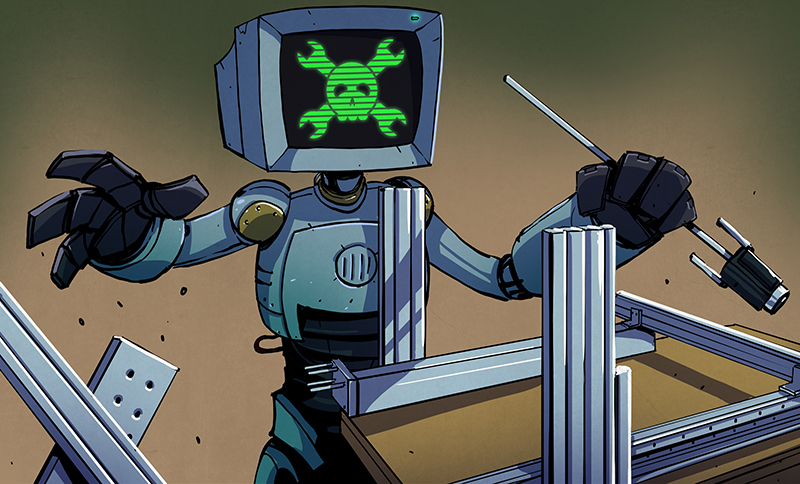
T-slot extrusions used to be somewhat mysterious, but today they are quite common thanks to their use in many 3D printers. However, it is one thing to assemble a kit with some extrusions and another thing to design your own creations with the material. If you ever had a Play-Doh Fun Factory as a kid, then you know about extrusions. You push some material out through a die to make a shape. Of course, aluminum extrusions aren’t made from modeling clay, but usually 6105-T5 aluminum. Oddly, there doesn’t seem to be an official standard, but it is so common that there’s usually not much variation between different vendors.
We use extrusions to create frames for 3D printers, laser cutters, and CNC machines. But you can use it anywhere you need a sturdy and versatile frame. There seems to be a lot of people using them, for example, to build custom fixtures inside vans. If you need a custom workbench, a light fixture, or even a picture frame, you can build anything you like using extrusions.
Why Extrusions?
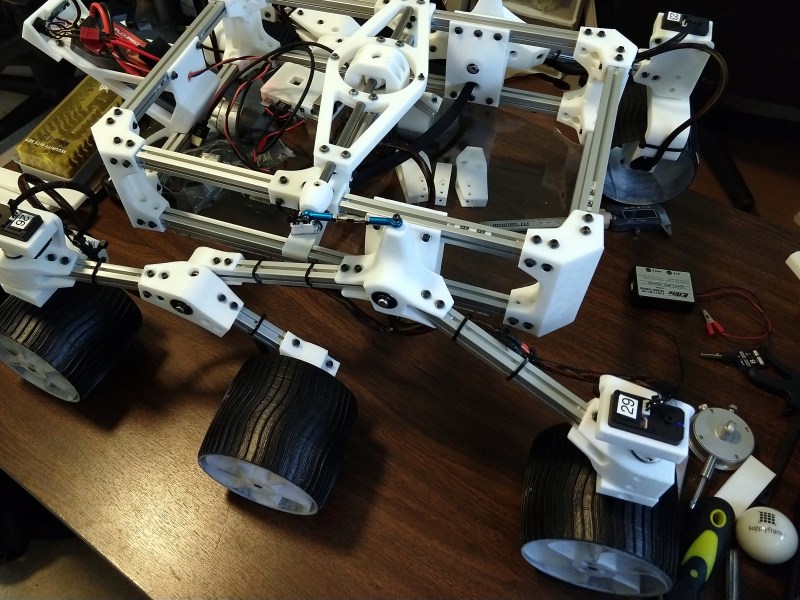
If you are handy enough, of course, you can build all of those things without resorting to aluminum extrusion. After all, it isn’t hard to build a box out of wood or even aluminum stock. But having stock inexpensive aluminum is both strong and convenient. In general, all you need is a way to cut the extrusion square (or, buy it in the lengths you want) and a way to drill holes in the relatively soft aluminum. In some cases, you may want to tap some holes — either that already exist or those you freshly drilled.
However, what you do need is a lot of special parts. There are brackets and special nuts and a variety of accessories. You can think of it as something akin to an adult Erector set. One thing that has made working with extrusions easier is that you can 3D print just the bracket you need in many cases instead of buying an exotic bracket or having to stock a lot of different items. A fantastic example of this are all of the brackets and retaining parts Roger Cheng covered in his guide How to Build Anything Out of Aluminum Extrusion and 3D Printed Brackets.
Extrusion Geometry

There isn’t just a single kind of extrusion, but they all share some common features. In general, the extrusion will be like a square or a rectangle. The most basic extrusions are square and there will be a central hole and one or more T slots for attaching things. If you are making something you want to be attractive, you might not want the T slot on all sides, but usually, with a 3D printer or other machines you’ll have a slot on all sides.
Some extrusions are metric and some use inch measurements. It is common to call a square profile by its measurement as in a 20×20 profile (20mm on each side).

More complex extrusions will usually repeat the pattern so a 40×20 extrusion appears like two 20×20 extrusions joined together. Of course, they aren’t made that way — it is one solid extrusion where they’re squeezed out like Play-Doh, a fascinating story that Dan Maloney dove into last year. However, there are other extrusion shapes, such as those with a radius or those shaped like triangles for special purposes.
There are two things you’ll need to do: join extrusions together securely and affix things to the extrusions. For example, if you are making a table, you’d want to build a frame to hold the desktop that has four legs. You’d attach a laminate tabletop to the frame and put leveling feet in the legs. Of course, you could get a lot fancier like [Evan] and [Katelyn] did in the video below.
Extrusion Connections
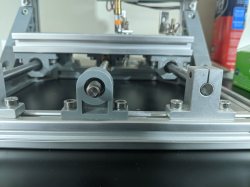
In many cases, attaching accessories like a foot or a bracket to an extrusion has a lot in common with how you join multiple extrusions together, so let’s attack that first. The trick is to use special nuts that fit inside the T slots. You have several options. Square nuts can slide into the slot if they are thin enough. You can put a tension spring on the nut to hold it in place while you tighten the bolt into the nut. However, usually, people just thread the bolt on and slide the whole thing into the slot.
The downside to this is that you have to have access to the open end of the slot. If you want to add something between two other nuts or if the slot is blocked with a bracket, you will have to tear everything apart to get the new nut in. This is a type of preset nut, and they also make rectangular nuts known as T nuts that serve the same purpose.
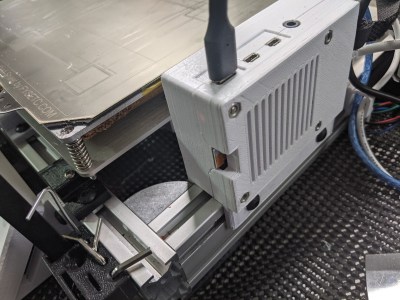
If you were, for example, affixing a stepper motor bracket with two mounting holes to your frame, you’d either insert the nuts or thread them loosely on the bolts inserted into the bracket and then slide them into the slot. When you have the assembly in the right position, you simply tighten the bolts.
The only tricky part is the length of the bolt to use. You need a bolt that will go through the bracket and just go into the nut without coming out the other side and touching the extrusion. If the bracket were, say, 10mm thick and the nut is 6mm thick, you might use a 15mm long bolt to leave a millimeter margin. If the bolt is too short, the joint won’t be sturdy.
If you need to add something to the middle of an extrusion where you can’t access the entrance to the T slot, you’ll need a special kind of T nut. These are the least secure attachment but are often good enough. These nuts have an elliptical shape so that when they rotate 90 degrees they get stuck in the slot. There are also nuts that have springs or set screws so you can put them in the slot at an angle and then rotate the long edge to compress the spring, allowing the nut to clear the slot. When you let go, the spring pushes the nut into the edge of the slot, locking it in place. These are sometimes called drop-in or roll-in nuts.
You can also get T head bolts where the bolt head fits into the slot instead of the nut. These look like T nuts, but have a threaded bolt instead of a threaded hole. They also make T nuts that have multiple threaded holes. For example, a corner bracket — something we’ll talk about shortly — might have three holes spaced every 20mm, and there will be a corresponding nut with 3 holes with the same spacing. Of course, you could always just use three regular nuts.
Joining Extrusions
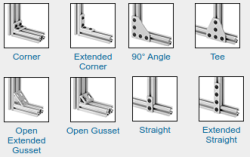
You can attach a stepper motor bracket or a cabinet slide using T nuts and bolts. But you can also attach a bracket to two or more extrusions to join them together. They make these brackets in aluminum, steel, or polymer, of course, but you can also 3D print them. However, you need to be careful. Usually, the brackets only constrain the extrusions in two dimensions, so you’ll want to use a second method to overconstrain the joint.
Most brackets are exactly what you’d think — they are shaped somewhat like an L or a T or a plus sign but there are a dizzying array of options. There are also corner connectors for making boxes that have an XYZ configuration. However, you can also get inner brackets that look like two T nuts in an L shape. A set screw holds each leg of the L in place. Some have an angled set screw to help align the connection in which case, you have to use a different type of inner connector depending on which way the connector faces. You’ll usually use these in pairs to hold both sides of the extrusion, although that’s not always necessary. You can see an example of a simple inner connector in the video below.
Sometimes you want to just join two extrusions end-to-end. A linear connector can do that. It is just a strip of metal that fits in the slot and has a few holes for set screws. You can also get brackets that will let you put a piece of extrusion in as a diagonal brace for extra strength.
There is also a simple way to connect two extrusions without using a bracket at all. It is more work, though, but uses fewer parts. Suppose you want to join extrusion A and B at a right angle. Your first step is to tap the central hole (or holes) in extrusion A. Then you drill a normal hole through extrusion B big enough to get a hex key for your bolt through the hole. You thread a bolt into the threaded hole, but before it is tight, you slide the head of the bolt into B’s T slot. The hole in B is positioned so you can finish tightening the bolt.
Accessories
There are many things made to work with extrusions you can get from the same place you buy them. There are cover plates, feet, and casters. You can get springs that hold sheet material like acrylic in the T slot. There are wheels, doors, handles, and hinges all made to fit into T slots.
If you browse any of the 3D printing sites like Thingiverse, you’ll find there are many designs for things like spool holders, filament guides, tool holders, and lamps that will fit in a T slot either as a friction fit or by mounting with nuts. Just remember that if you want to add something later and it needs screws, you’ll probably want some kind of drop-in nut.
Where to Get Extrusion
The cheapest way to buy extrusion is to get it surplus in whatever lengths you can get — usually leftovers — and cut them to the size you want yourself. If you do cut it yourself, you’ll want to be sure to make a clean and square cut so that the extrusions square up when you attach them together. You’ll want to use a metal cutting blade, of course.
However, if you buy new extrusions you can usually get them cut very precisely to whatever size you need. This may also cut down on expensive shipping for long pieces that you’ll cut anyway. In addition to cuts, you can often get the material in different colors or metal alloys. You can also ask for holes on one or both ends to be tapped if you prefer not to do that yourself.
There are many places you can buy extrusions and related items. Misumi is a common option as is 8020. The big suppliers like Grainger, Fastenal, and McMaster-Carr carry a lot of this sort of thing, but they are often pretty expensive.
The 3D Printing Connection
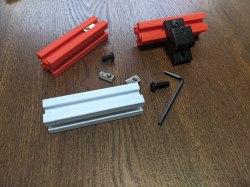
You can 3D print a lot of brackets (including one that is apparently the world’s best) and accessories and if you want to model something, you can even 3D print extrusions, although you need your print tolerances pretty tight. There are many designs for plastic T nuts that take a normal nut for threading and a plethora of brackets of all descriptions.
There are a few things to watch out for, though. First, use common sense. plastic brackets and extrusions won’t be as strong as those made of metal, although we’ve seen people go overboard with the idea. Also, not all extrusions are exactly the same, so a design for a nut that fits brand X might not fit the ones you have. As always with 3D printing, you’ll need to tweak and adjust.
If you want to get fancy with your designs and maybe even use 3D printed holders for cheap nuts. Either way, if you are building a desk, a machine, a robot, or nearly anything else you can imagine, aluminum extrusions are a great thing to have in your toolkit.
0 Commentaires